Impact of Mergers and Acquisitions on the Energy Sector
VerifiedAdded on 2020/01/23
|11
|3912
|389
Report
AI Summary
This report provides a comprehensive analysis of merger and acquisition (M&A) strategies within the energy sector, particularly in response to oil price fluctuations. It explores how companies utilize M&A to navigate challenges and capitalize on opportunities, including specific examples like the Shell-BG merger and the merger of FMC technology of the US and Technip of France. The report highlights the benefits of M&A, such as market expansion and resource optimization, while also addressing significant challenges, including employee integration, cultural clashes, decision-making conflicts, regulatory issues, and potential productivity losses. Through case studies and strategic evaluations, the report offers insights into the dynamics of M&A within the energy industry and its impact on long-term viability and growth.
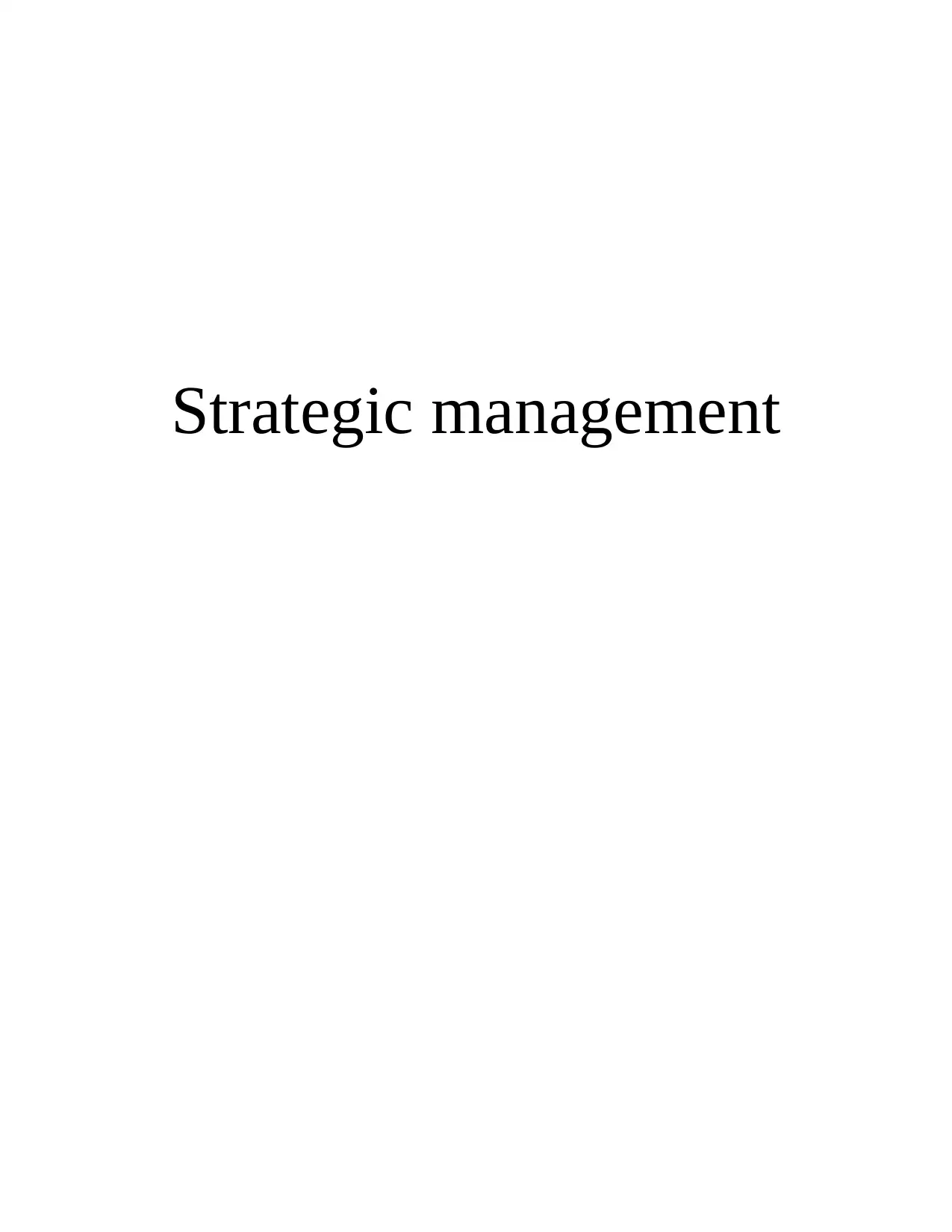
Strategic management
Paraphrase This Document
Need a fresh take? Get an instant paraphrase of this document with our AI Paraphraser
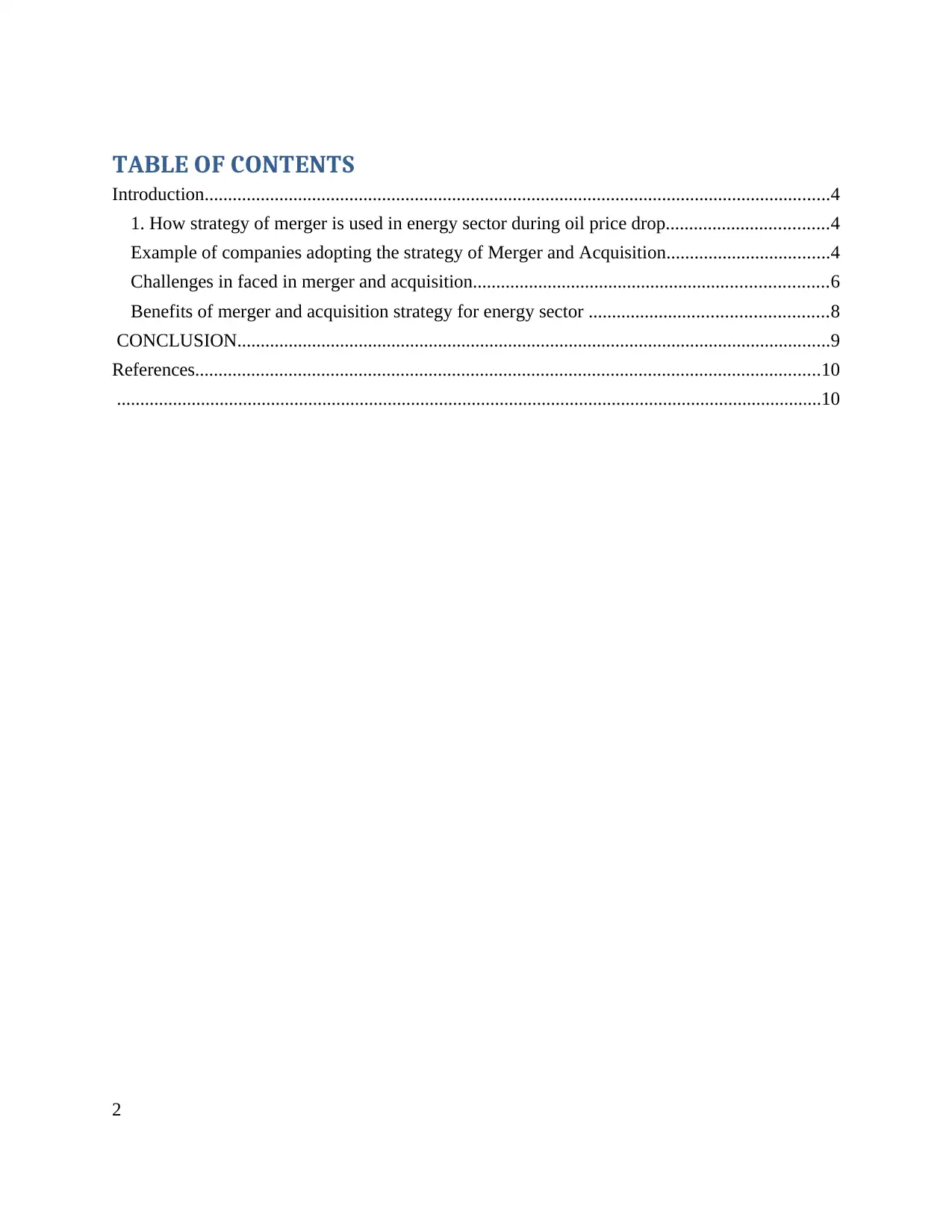
TABLE OF CONTENTS
Introduction......................................................................................................................................4
1. How strategy of merger is used in energy sector during oil price drop...................................4
Example of companies adopting the strategy of Merger and Acquisition...................................4
Challenges in faced in merger and acquisition............................................................................6
Benefits of merger and acquisition strategy for energy sector ...................................................8
CONCLUSION...............................................................................................................................9
References......................................................................................................................................10
.......................................................................................................................................................10
2
Introduction......................................................................................................................................4
1. How strategy of merger is used in energy sector during oil price drop...................................4
Example of companies adopting the strategy of Merger and Acquisition...................................4
Challenges in faced in merger and acquisition............................................................................6
Benefits of merger and acquisition strategy for energy sector ...................................................8
CONCLUSION...............................................................................................................................9
References......................................................................................................................................10
.......................................................................................................................................................10
2
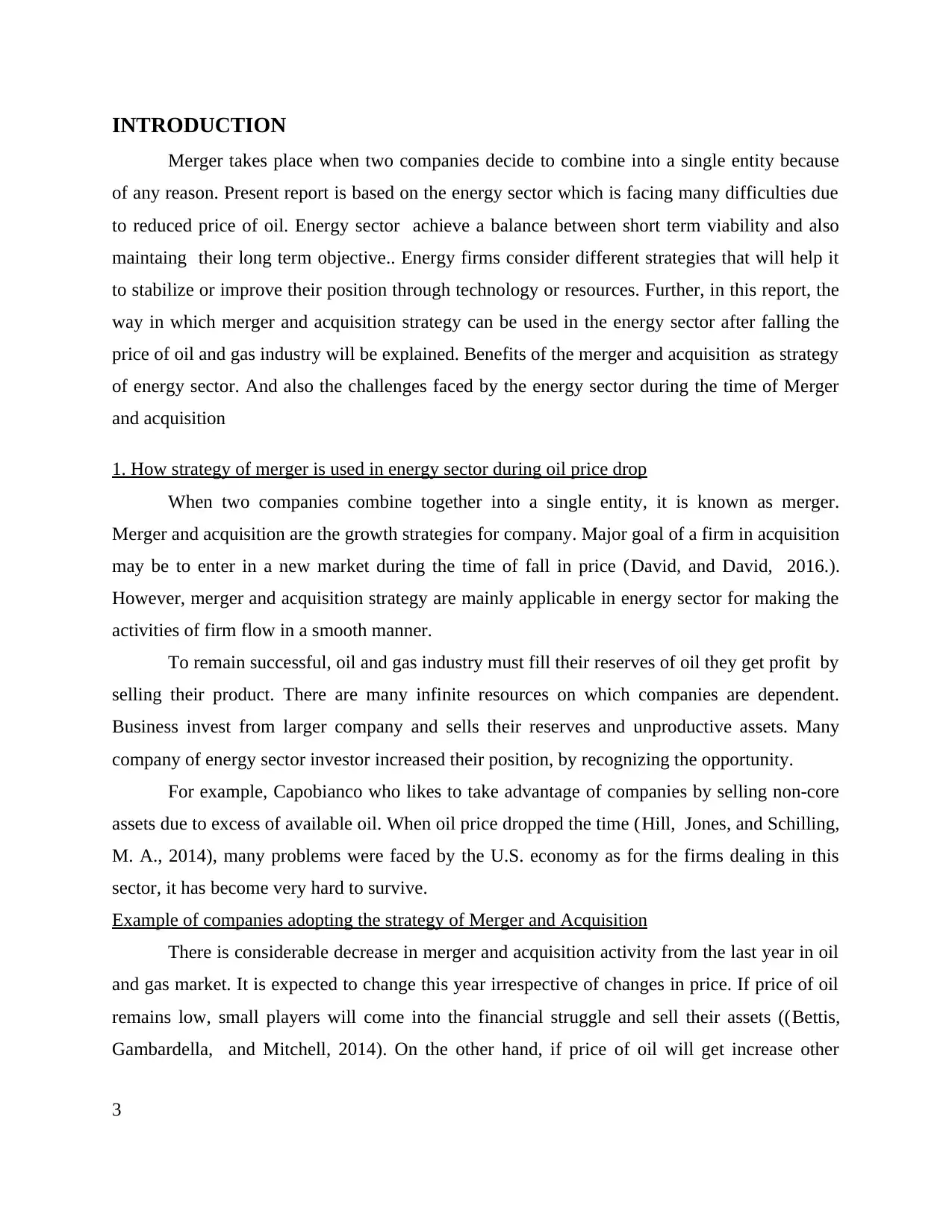
INTRODUCTION
Merger takes place when two companies decide to combine into a single entity because
of any reason. Present report is based on the energy sector which is facing many difficulties due
to reduced price of oil. Energy sector achieve a balance between short term viability and also
maintaing their long term objective.. Energy firms consider different strategies that will help it
to stabilize or improve their position through technology or resources. Further, in this report, the
way in which merger and acquisition strategy can be used in the energy sector after falling the
price of oil and gas industry will be explained. Benefits of the merger and acquisition as strategy
of energy sector. And also the challenges faced by the energy sector during the time of Merger
and acquisition
1. How strategy of merger is used in energy sector during oil price drop
When two companies combine together into a single entity, it is known as merger.
Merger and acquisition are the growth strategies for company. Major goal of a firm in acquisition
may be to enter in a new market during the time of fall in price (David, and David, 2016.).
However, merger and acquisition strategy are mainly applicable in energy sector for making the
activities of firm flow in a smooth manner.
To remain successful, oil and gas industry must fill their reserves of oil they get profit by
selling their product. There are many infinite resources on which companies are dependent.
Business invest from larger company and sells their reserves and unproductive assets. Many
company of energy sector investor increased their position, by recognizing the opportunity.
For example, Capobianco who likes to take advantage of companies by selling non-core
assets due to excess of available oil. When oil price dropped the time (Hill, Jones, and Schilling,
M. A., 2014), many problems were faced by the U.S. economy as for the firms dealing in this
sector, it has become very hard to survive.
Example of companies adopting the strategy of Merger and Acquisition
There is considerable decrease in merger and acquisition activity from the last year in oil
and gas market. It is expected to change this year irrespective of changes in price. If price of oil
remains low, small players will come into the financial struggle and sell their assets ((Bettis,
Gambardella, and Mitchell, 2014). On the other hand, if price of oil will get increase other
3
Merger takes place when two companies decide to combine into a single entity because
of any reason. Present report is based on the energy sector which is facing many difficulties due
to reduced price of oil. Energy sector achieve a balance between short term viability and also
maintaing their long term objective.. Energy firms consider different strategies that will help it
to stabilize or improve their position through technology or resources. Further, in this report, the
way in which merger and acquisition strategy can be used in the energy sector after falling the
price of oil and gas industry will be explained. Benefits of the merger and acquisition as strategy
of energy sector. And also the challenges faced by the energy sector during the time of Merger
and acquisition
1. How strategy of merger is used in energy sector during oil price drop
When two companies combine together into a single entity, it is known as merger.
Merger and acquisition are the growth strategies for company. Major goal of a firm in acquisition
may be to enter in a new market during the time of fall in price (David, and David, 2016.).
However, merger and acquisition strategy are mainly applicable in energy sector for making the
activities of firm flow in a smooth manner.
To remain successful, oil and gas industry must fill their reserves of oil they get profit by
selling their product. There are many infinite resources on which companies are dependent.
Business invest from larger company and sells their reserves and unproductive assets. Many
company of energy sector investor increased their position, by recognizing the opportunity.
For example, Capobianco who likes to take advantage of companies by selling non-core
assets due to excess of available oil. When oil price dropped the time (Hill, Jones, and Schilling,
M. A., 2014), many problems were faced by the U.S. economy as for the firms dealing in this
sector, it has become very hard to survive.
Example of companies adopting the strategy of Merger and Acquisition
There is considerable decrease in merger and acquisition activity from the last year in oil
and gas market. It is expected to change this year irrespective of changes in price. If price of oil
remains low, small players will come into the financial struggle and sell their assets ((Bettis,
Gambardella, and Mitchell, 2014). On the other hand, if price of oil will get increase other
3
⊘ This is a preview!⊘
Do you want full access?
Subscribe today to unlock all pages.

Trusted by 1+ million students worldwide
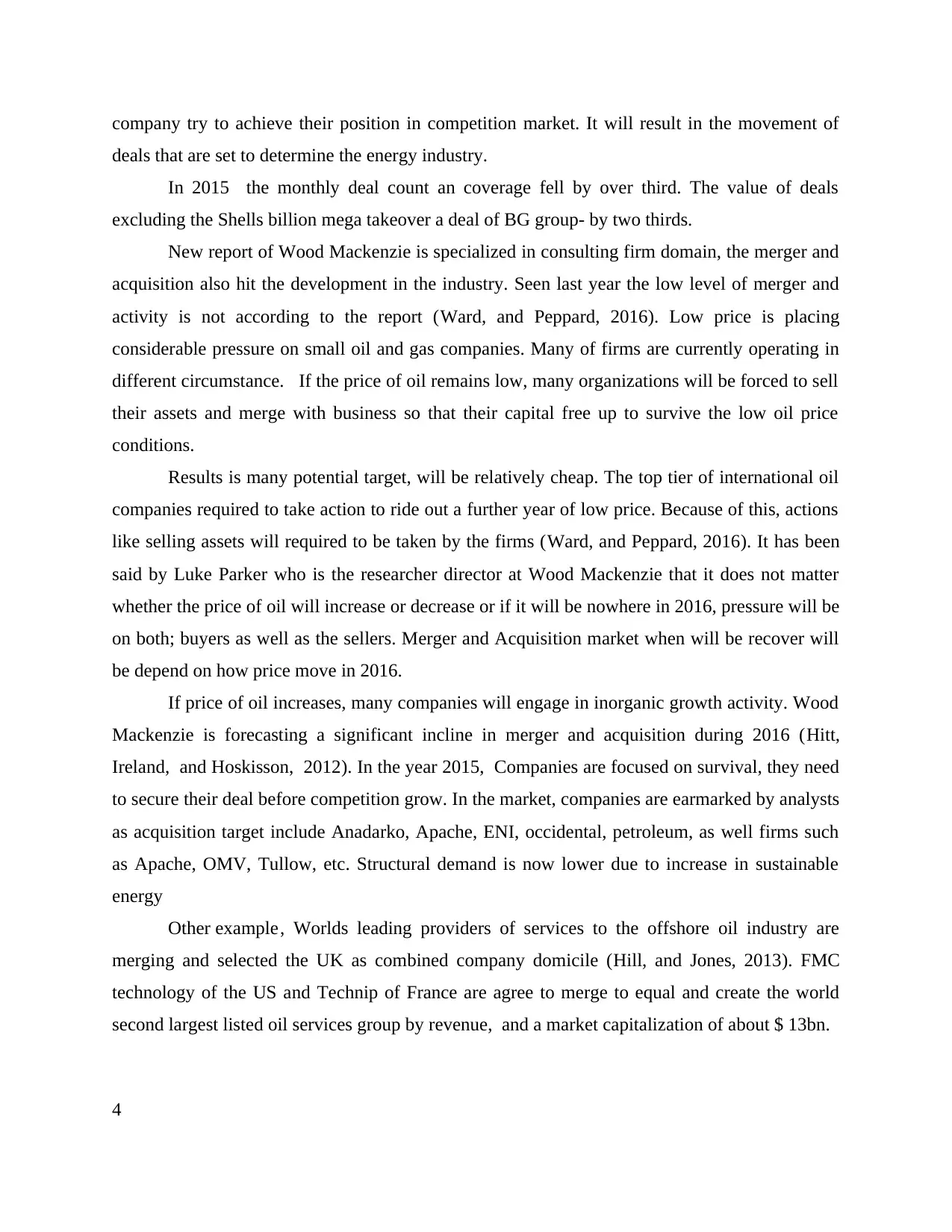
company try to achieve their position in competition market. It will result in the movement of
deals that are set to determine the energy industry.
In 2015 the monthly deal count an coverage fell by over third. The value of deals
excluding the Shells billion mega takeover a deal of BG group- by two thirds.
New report of Wood Mackenzie is specialized in consulting firm domain, the merger and
acquisition also hit the development in the industry. Seen last year the low level of merger and
activity is not according to the report (Ward, and Peppard, 2016). Low price is placing
considerable pressure on small oil and gas companies. Many of firms are currently operating in
different circumstance. If the price of oil remains low, many organizations will be forced to sell
their assets and merge with business so that their capital free up to survive the low oil price
conditions.
Results is many potential target, will be relatively cheap. The top tier of international oil
companies required to take action to ride out a further year of low price. Because of this, actions
like selling assets will required to be taken by the firms (Ward, and Peppard, 2016). It has been
said by Luke Parker who is the researcher director at Wood Mackenzie that it does not matter
whether the price of oil will increase or decrease or if it will be nowhere in 2016, pressure will be
on both; buyers as well as the sellers. Merger and Acquisition market when will be recover will
be depend on how price move in 2016.
If price of oil increases, many companies will engage in inorganic growth activity. Wood
Mackenzie is forecasting a significant incline in merger and acquisition during 2016 (Hitt,
Ireland, and Hoskisson, 2012). In the year 2015, Companies are focused on survival, they need
to secure their deal before competition grow. In the market, companies are earmarked by analysts
as acquisition target include Anadarko, Apache, ENI, occidental, petroleum, as well firms such
as Apache, OMV, Tullow, etc. Structural demand is now lower due to increase in sustainable
energy
Other example, Worlds leading providers of services to the offshore oil industry are
merging and selected the UK as combined company domicile (Hill, and Jones, 2013). FMC
technology of the US and Technip of France are agree to merge to equal and create the world
second largest listed oil services group by revenue, and a market capitalization of about $ 13bn.
4
deals that are set to determine the energy industry.
In 2015 the monthly deal count an coverage fell by over third. The value of deals
excluding the Shells billion mega takeover a deal of BG group- by two thirds.
New report of Wood Mackenzie is specialized in consulting firm domain, the merger and
acquisition also hit the development in the industry. Seen last year the low level of merger and
activity is not according to the report (Ward, and Peppard, 2016). Low price is placing
considerable pressure on small oil and gas companies. Many of firms are currently operating in
different circumstance. If the price of oil remains low, many organizations will be forced to sell
their assets and merge with business so that their capital free up to survive the low oil price
conditions.
Results is many potential target, will be relatively cheap. The top tier of international oil
companies required to take action to ride out a further year of low price. Because of this, actions
like selling assets will required to be taken by the firms (Ward, and Peppard, 2016). It has been
said by Luke Parker who is the researcher director at Wood Mackenzie that it does not matter
whether the price of oil will increase or decrease or if it will be nowhere in 2016, pressure will be
on both; buyers as well as the sellers. Merger and Acquisition market when will be recover will
be depend on how price move in 2016.
If price of oil increases, many companies will engage in inorganic growth activity. Wood
Mackenzie is forecasting a significant incline in merger and acquisition during 2016 (Hitt,
Ireland, and Hoskisson, 2012). In the year 2015, Companies are focused on survival, they need
to secure their deal before competition grow. In the market, companies are earmarked by analysts
as acquisition target include Anadarko, Apache, ENI, occidental, petroleum, as well firms such
as Apache, OMV, Tullow, etc. Structural demand is now lower due to increase in sustainable
energy
Other example, Worlds leading providers of services to the offshore oil industry are
merging and selected the UK as combined company domicile (Hill, and Jones, 2013). FMC
technology of the US and Technip of France are agree to merge to equal and create the world
second largest listed oil services group by revenue, and a market capitalization of about $ 13bn.
4
Paraphrase This Document
Need a fresh take? Get an instant paraphrase of this document with our AI Paraphraser
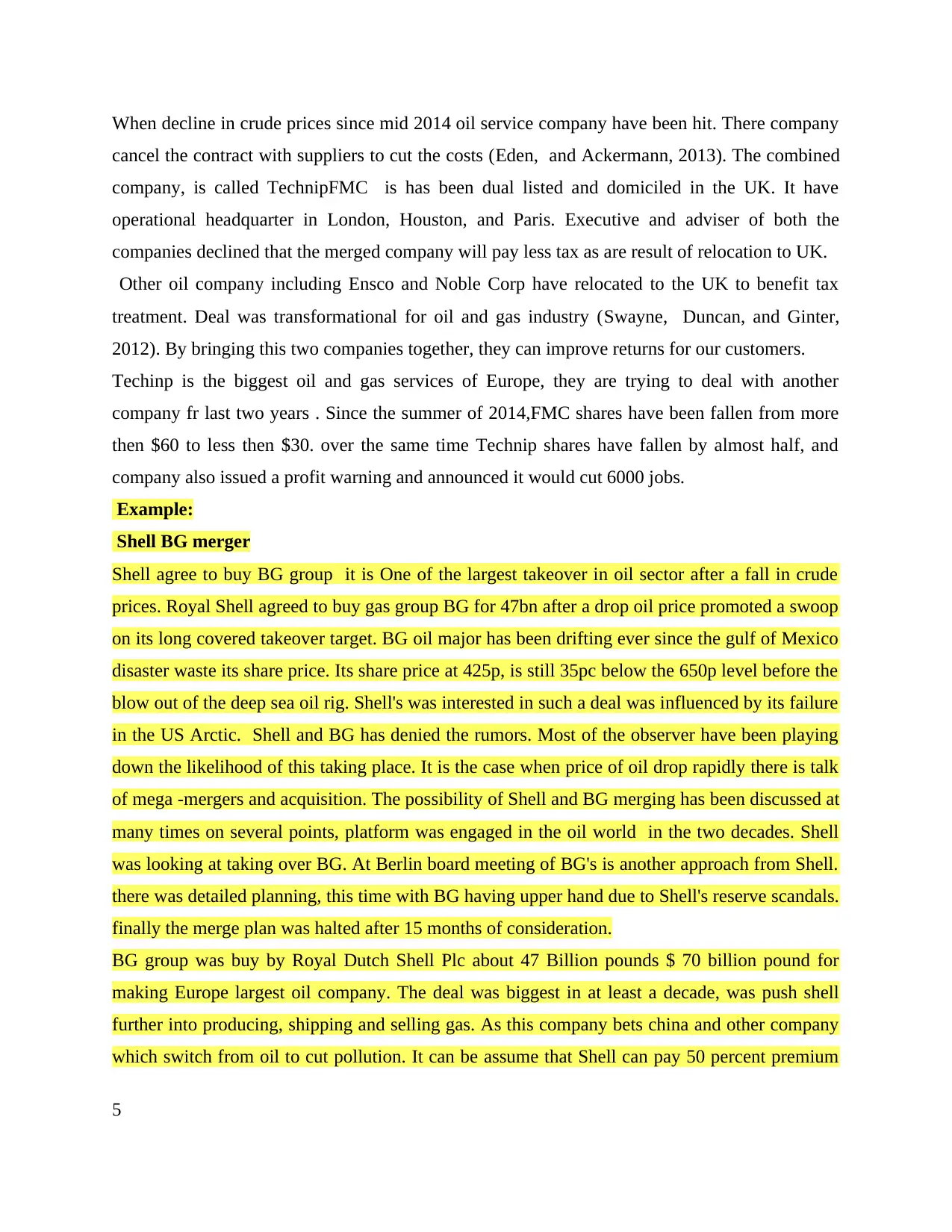
When decline in crude prices since mid 2014 oil service company have been hit. There company
cancel the contract with suppliers to cut the costs (Eden, and Ackermann, 2013). The combined
company, is called TechnipFMC is has been dual listed and domiciled in the UK. It have
operational headquarter in London, Houston, and Paris. Executive and adviser of both the
companies declined that the merged company will pay less tax as are result of relocation to UK.
Other oil company including Ensco and Noble Corp have relocated to the UK to benefit tax
treatment. Deal was transformational for oil and gas industry (Swayne, Duncan, and Ginter,
2012). By bringing this two companies together, they can improve returns for our customers.
Techinp is the biggest oil and gas services of Europe, they are trying to deal with another
company fr last two years . Since the summer of 2014,FMC shares have been fallen from more
then $60 to less then $30. over the same time Technip shares have fallen by almost half, and
company also issued a profit warning and announced it would cut 6000 jobs.
Example:
Shell BG merger
Shell agree to buy BG group it is One of the largest takeover in oil sector after a fall in crude
prices. Royal Shell agreed to buy gas group BG for 47bn after a drop oil price promoted a swoop
on its long covered takeover target. BG oil major has been drifting ever since the gulf of Mexico
disaster waste its share price. Its share price at 425p, is still 35pc below the 650p level before the
blow out of the deep sea oil rig. Shell's was interested in such a deal was influenced by its failure
in the US Arctic. Shell and BG has denied the rumors. Most of the observer have been playing
down the likelihood of this taking place. It is the case when price of oil drop rapidly there is talk
of mega -mergers and acquisition. The possibility of Shell and BG merging has been discussed at
many times on several points, platform was engaged in the oil world in the two decades. Shell
was looking at taking over BG. At Berlin board meeting of BG's is another approach from Shell.
there was detailed planning, this time with BG having upper hand due to Shell's reserve scandals.
finally the merge plan was halted after 15 months of consideration.
BG group was buy by Royal Dutch Shell Plc about 47 Billion pounds $ 70 billion pound for
making Europe largest oil company. The deal was biggest in at least a decade, was push shell
further into producing, shipping and selling gas. As this company bets china and other company
which switch from oil to cut pollution. It can be assume that Shell can pay 50 percent premium
5
cancel the contract with suppliers to cut the costs (Eden, and Ackermann, 2013). The combined
company, is called TechnipFMC is has been dual listed and domiciled in the UK. It have
operational headquarter in London, Houston, and Paris. Executive and adviser of both the
companies declined that the merged company will pay less tax as are result of relocation to UK.
Other oil company including Ensco and Noble Corp have relocated to the UK to benefit tax
treatment. Deal was transformational for oil and gas industry (Swayne, Duncan, and Ginter,
2012). By bringing this two companies together, they can improve returns for our customers.
Techinp is the biggest oil and gas services of Europe, they are trying to deal with another
company fr last two years . Since the summer of 2014,FMC shares have been fallen from more
then $60 to less then $30. over the same time Technip shares have fallen by almost half, and
company also issued a profit warning and announced it would cut 6000 jobs.
Example:
Shell BG merger
Shell agree to buy BG group it is One of the largest takeover in oil sector after a fall in crude
prices. Royal Shell agreed to buy gas group BG for 47bn after a drop oil price promoted a swoop
on its long covered takeover target. BG oil major has been drifting ever since the gulf of Mexico
disaster waste its share price. Its share price at 425p, is still 35pc below the 650p level before the
blow out of the deep sea oil rig. Shell's was interested in such a deal was influenced by its failure
in the US Arctic. Shell and BG has denied the rumors. Most of the observer have been playing
down the likelihood of this taking place. It is the case when price of oil drop rapidly there is talk
of mega -mergers and acquisition. The possibility of Shell and BG merging has been discussed at
many times on several points, platform was engaged in the oil world in the two decades. Shell
was looking at taking over BG. At Berlin board meeting of BG's is another approach from Shell.
there was detailed planning, this time with BG having upper hand due to Shell's reserve scandals.
finally the merge plan was halted after 15 months of consideration.
BG group was buy by Royal Dutch Shell Plc about 47 Billion pounds $ 70 billion pound for
making Europe largest oil company. The deal was biggest in at least a decade, was push shell
further into producing, shipping and selling gas. As this company bets china and other company
which switch from oil to cut pollution. It can be assume that Shell can pay 50 percent premium
5
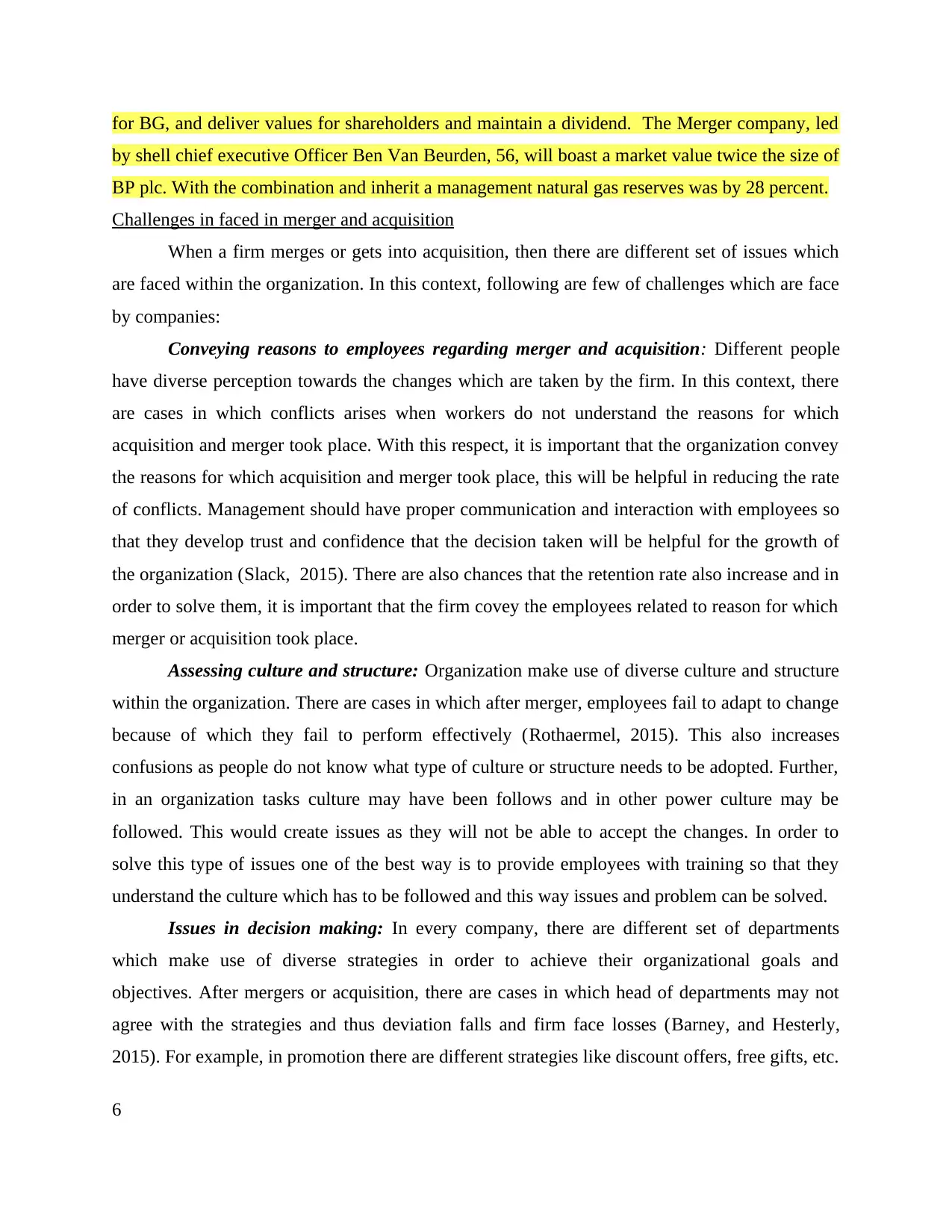
for BG, and deliver values for shareholders and maintain a dividend. The Merger company, led
by shell chief executive Officer Ben Van Beurden, 56, will boast a market value twice the size of
BP plc. With the combination and inherit a management natural gas reserves was by 28 percent.
Challenges in faced in merger and acquisition
When a firm merges or gets into acquisition, then there are different set of issues which
are faced within the organization. In this context, following are few of challenges which are face
by companies:
Conveying reasons to employees regarding merger and acquisition: Different people
have diverse perception towards the changes which are taken by the firm. In this context, there
are cases in which conflicts arises when workers do not understand the reasons for which
acquisition and merger took place. With this respect, it is important that the organization convey
the reasons for which acquisition and merger took place, this will be helpful in reducing the rate
of conflicts. Management should have proper communication and interaction with employees so
that they develop trust and confidence that the decision taken will be helpful for the growth of
the organization (Slack, 2015). There are also chances that the retention rate also increase and in
order to solve them, it is important that the firm covey the employees related to reason for which
merger or acquisition took place.
Assessing culture and structure: Organization make use of diverse culture and structure
within the organization. There are cases in which after merger, employees fail to adapt to change
because of which they fail to perform effectively (Rothaermel, 2015). This also increases
confusions as people do not know what type of culture or structure needs to be adopted. Further,
in an organization tasks culture may have been follows and in other power culture may be
followed. This would create issues as they will not be able to accept the changes. In order to
solve this type of issues one of the best way is to provide employees with training so that they
understand the culture which has to be followed and this way issues and problem can be solved.
Issues in decision making: In every company, there are different set of departments
which make use of diverse strategies in order to achieve their organizational goals and
objectives. After mergers or acquisition, there are cases in which head of departments may not
agree with the strategies and thus deviation falls and firm face losses (Barney, and Hesterly,
2015). For example, in promotion there are different strategies like discount offers, free gifts, etc.
6
by shell chief executive Officer Ben Van Beurden, 56, will boast a market value twice the size of
BP plc. With the combination and inherit a management natural gas reserves was by 28 percent.
Challenges in faced in merger and acquisition
When a firm merges or gets into acquisition, then there are different set of issues which
are faced within the organization. In this context, following are few of challenges which are face
by companies:
Conveying reasons to employees regarding merger and acquisition: Different people
have diverse perception towards the changes which are taken by the firm. In this context, there
are cases in which conflicts arises when workers do not understand the reasons for which
acquisition and merger took place. With this respect, it is important that the organization convey
the reasons for which acquisition and merger took place, this will be helpful in reducing the rate
of conflicts. Management should have proper communication and interaction with employees so
that they develop trust and confidence that the decision taken will be helpful for the growth of
the organization (Slack, 2015). There are also chances that the retention rate also increase and in
order to solve them, it is important that the firm covey the employees related to reason for which
merger or acquisition took place.
Assessing culture and structure: Organization make use of diverse culture and structure
within the organization. There are cases in which after merger, employees fail to adapt to change
because of which they fail to perform effectively (Rothaermel, 2015). This also increases
confusions as people do not know what type of culture or structure needs to be adopted. Further,
in an organization tasks culture may have been follows and in other power culture may be
followed. This would create issues as they will not be able to accept the changes. In order to
solve this type of issues one of the best way is to provide employees with training so that they
understand the culture which has to be followed and this way issues and problem can be solved.
Issues in decision making: In every company, there are different set of departments
which make use of diverse strategies in order to achieve their organizational goals and
objectives. After mergers or acquisition, there are cases in which head of departments may not
agree with the strategies and thus deviation falls and firm face losses (Barney, and Hesterly,
2015). For example, in promotion there are different strategies like discount offers, free gifts, etc.
6
⊘ This is a preview!⊘
Do you want full access?
Subscribe today to unlock all pages.

Trusted by 1+ million students worldwide
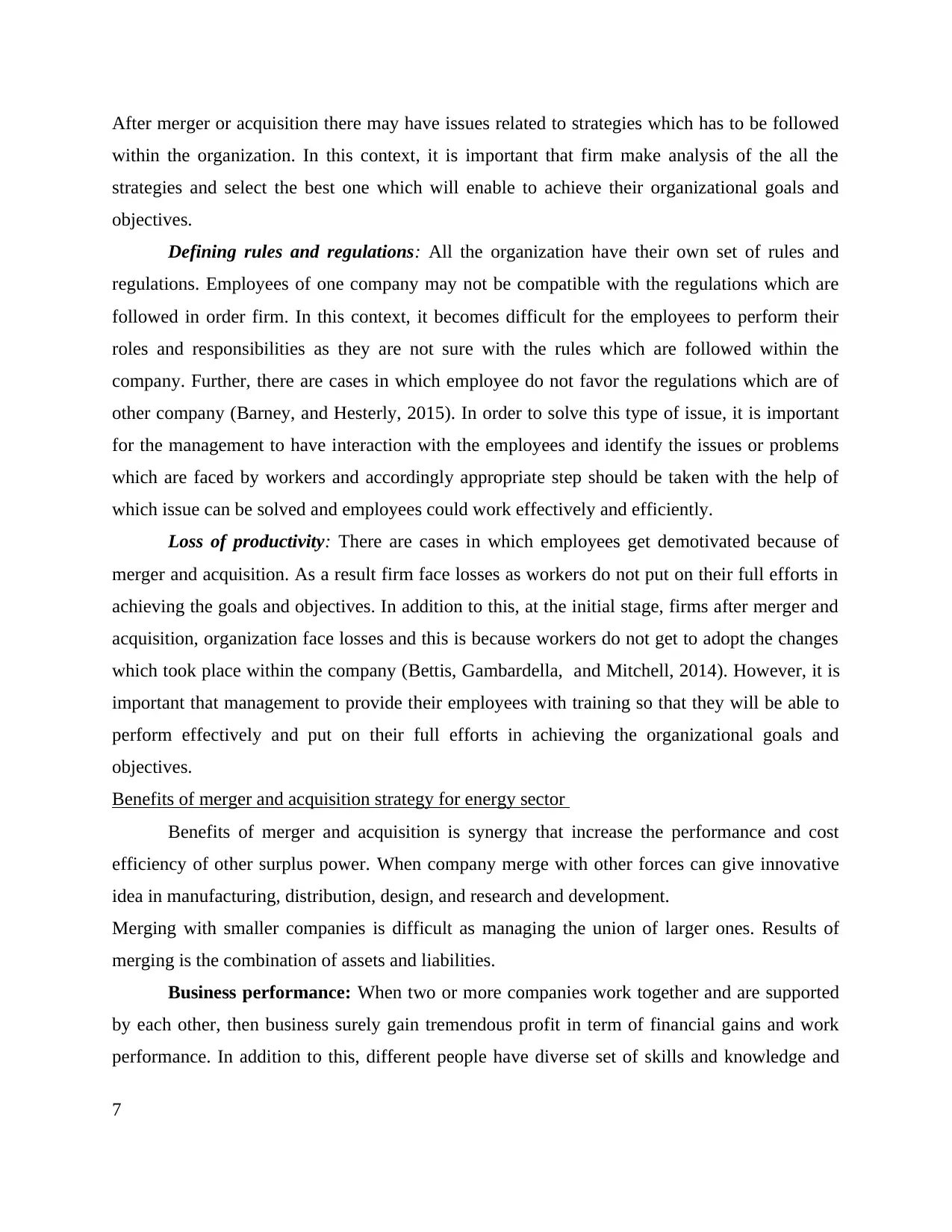
After merger or acquisition there may have issues related to strategies which has to be followed
within the organization. In this context, it is important that firm make analysis of the all the
strategies and select the best one which will enable to achieve their organizational goals and
objectives.
Defining rules and regulations: All the organization have their own set of rules and
regulations. Employees of one company may not be compatible with the regulations which are
followed in order firm. In this context, it becomes difficult for the employees to perform their
roles and responsibilities as they are not sure with the rules which are followed within the
company. Further, there are cases in which employee do not favor the regulations which are of
other company (Barney, and Hesterly, 2015). In order to solve this type of issue, it is important
for the management to have interaction with the employees and identify the issues or problems
which are faced by workers and accordingly appropriate step should be taken with the help of
which issue can be solved and employees could work effectively and efficiently.
Loss of productivity: There are cases in which employees get demotivated because of
merger and acquisition. As a result firm face losses as workers do not put on their full efforts in
achieving the goals and objectives. In addition to this, at the initial stage, firms after merger and
acquisition, organization face losses and this is because workers do not get to adopt the changes
which took place within the company (Bettis, Gambardella, and Mitchell, 2014). However, it is
important that management to provide their employees with training so that they will be able to
perform effectively and put on their full efforts in achieving the organizational goals and
objectives.
Benefits of merger and acquisition strategy for energy sector
Benefits of merger and acquisition is synergy that increase the performance and cost
efficiency of other surplus power. When company merge with other forces can give innovative
idea in manufacturing, distribution, design, and research and development.
Merging with smaller companies is difficult as managing the union of larger ones. Results of
merging is the combination of assets and liabilities.
Business performance: When two or more companies work together and are supported
by each other, then business surely gain tremendous profit in term of financial gains and work
performance. In addition to this, different people have diverse set of skills and knowledge and
7
within the organization. In this context, it is important that firm make analysis of the all the
strategies and select the best one which will enable to achieve their organizational goals and
objectives.
Defining rules and regulations: All the organization have their own set of rules and
regulations. Employees of one company may not be compatible with the regulations which are
followed in order firm. In this context, it becomes difficult for the employees to perform their
roles and responsibilities as they are not sure with the rules which are followed within the
company. Further, there are cases in which employee do not favor the regulations which are of
other company (Barney, and Hesterly, 2015). In order to solve this type of issue, it is important
for the management to have interaction with the employees and identify the issues or problems
which are faced by workers and accordingly appropriate step should be taken with the help of
which issue can be solved and employees could work effectively and efficiently.
Loss of productivity: There are cases in which employees get demotivated because of
merger and acquisition. As a result firm face losses as workers do not put on their full efforts in
achieving the goals and objectives. In addition to this, at the initial stage, firms after merger and
acquisition, organization face losses and this is because workers do not get to adopt the changes
which took place within the company (Bettis, Gambardella, and Mitchell, 2014). However, it is
important that management to provide their employees with training so that they will be able to
perform effectively and put on their full efforts in achieving the organizational goals and
objectives.
Benefits of merger and acquisition strategy for energy sector
Benefits of merger and acquisition is synergy that increase the performance and cost
efficiency of other surplus power. When company merge with other forces can give innovative
idea in manufacturing, distribution, design, and research and development.
Merging with smaller companies is difficult as managing the union of larger ones. Results of
merging is the combination of assets and liabilities.
Business performance: When two or more companies work together and are supported
by each other, then business surely gain tremendous profit in term of financial gains and work
performance. In addition to this, different people have diverse set of skills and knowledge and
7
Paraphrase This Document
Need a fresh take? Get an instant paraphrase of this document with our AI Paraphraser
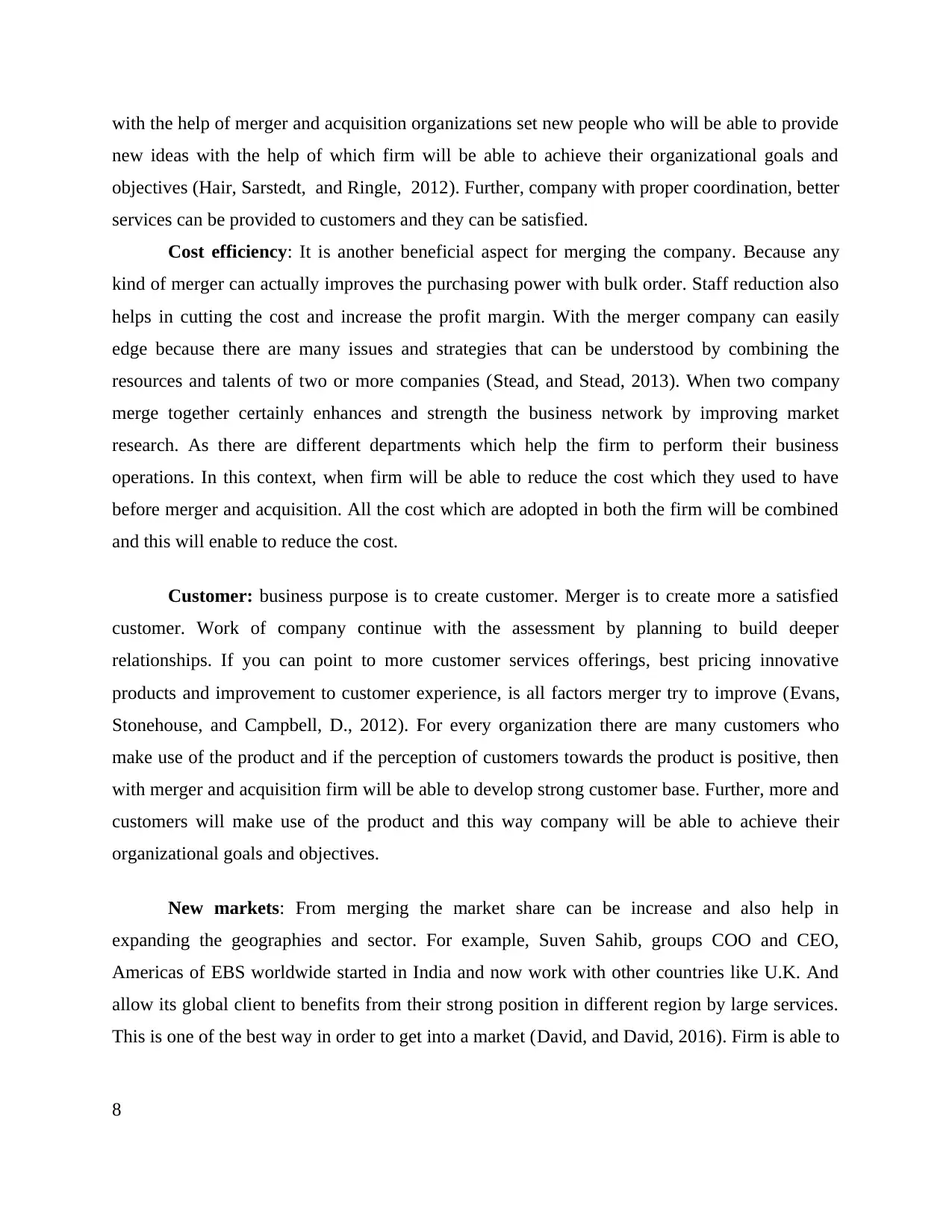
with the help of merger and acquisition organizations set new people who will be able to provide
new ideas with the help of which firm will be able to achieve their organizational goals and
objectives (Hair, Sarstedt, and Ringle, 2012). Further, company with proper coordination, better
services can be provided to customers and they can be satisfied.
Cost efficiency: It is another beneficial aspect for merging the company. Because any
kind of merger can actually improves the purchasing power with bulk order. Staff reduction also
helps in cutting the cost and increase the profit margin. With the merger company can easily
edge because there are many issues and strategies that can be understood by combining the
resources and talents of two or more companies (Stead, and Stead, 2013). When two company
merge together certainly enhances and strength the business network by improving market
research. As there are different departments which help the firm to perform their business
operations. In this context, when firm will be able to reduce the cost which they used to have
before merger and acquisition. All the cost which are adopted in both the firm will be combined
and this will enable to reduce the cost.
Customer: business purpose is to create customer. Merger is to create more a satisfied
customer. Work of company continue with the assessment by planning to build deeper
relationships. If you can point to more customer services offerings, best pricing innovative
products and improvement to customer experience, is all factors merger try to improve (Evans,
Stonehouse, and Campbell, D., 2012). For every organization there are many customers who
make use of the product and if the perception of customers towards the product is positive, then
with merger and acquisition firm will be able to develop strong customer base. Further, more and
customers will make use of the product and this way company will be able to achieve their
organizational goals and objectives.
New markets: From merging the market share can be increase and also help in
expanding the geographies and sector. For example, Suven Sahib, groups COO and CEO,
Americas of EBS worldwide started in India and now work with other countries like U.K. And
allow its global client to benefits from their strong position in different region by large services.
This is one of the best way in order to get into a market (David, and David, 2016). Firm is able to
8
new ideas with the help of which firm will be able to achieve their organizational goals and
objectives (Hair, Sarstedt, and Ringle, 2012). Further, company with proper coordination, better
services can be provided to customers and they can be satisfied.
Cost efficiency: It is another beneficial aspect for merging the company. Because any
kind of merger can actually improves the purchasing power with bulk order. Staff reduction also
helps in cutting the cost and increase the profit margin. With the merger company can easily
edge because there are many issues and strategies that can be understood by combining the
resources and talents of two or more companies (Stead, and Stead, 2013). When two company
merge together certainly enhances and strength the business network by improving market
research. As there are different departments which help the firm to perform their business
operations. In this context, when firm will be able to reduce the cost which they used to have
before merger and acquisition. All the cost which are adopted in both the firm will be combined
and this will enable to reduce the cost.
Customer: business purpose is to create customer. Merger is to create more a satisfied
customer. Work of company continue with the assessment by planning to build deeper
relationships. If you can point to more customer services offerings, best pricing innovative
products and improvement to customer experience, is all factors merger try to improve (Evans,
Stonehouse, and Campbell, D., 2012). For every organization there are many customers who
make use of the product and if the perception of customers towards the product is positive, then
with merger and acquisition firm will be able to develop strong customer base. Further, more and
customers will make use of the product and this way company will be able to achieve their
organizational goals and objectives.
New markets: From merging the market share can be increase and also help in
expanding the geographies and sector. For example, Suven Sahib, groups COO and CEO,
Americas of EBS worldwide started in India and now work with other countries like U.K. And
allow its global client to benefits from their strong position in different region by large services.
This is one of the best way in order to get into a market (David, and David, 2016). Firm is able to
8
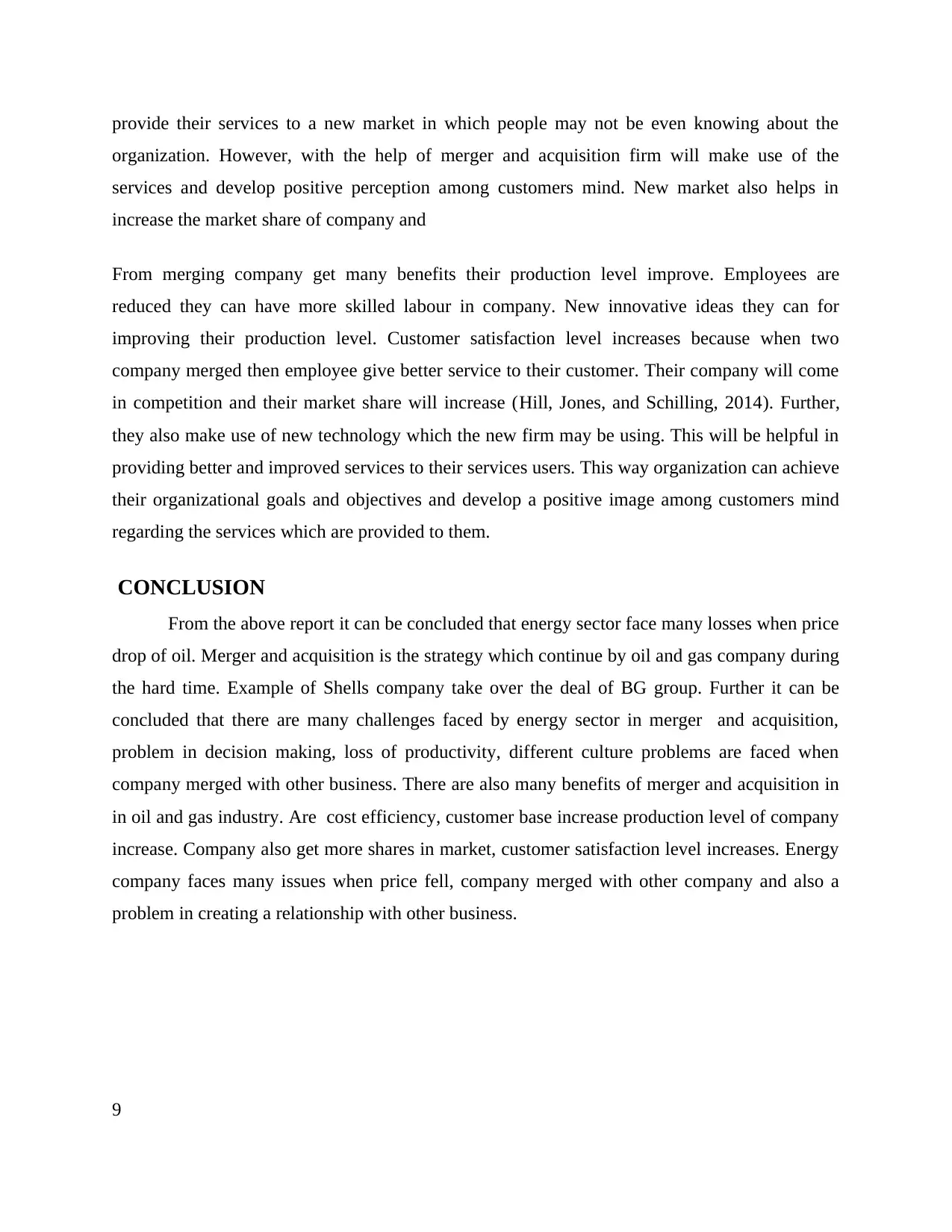
provide their services to a new market in which people may not be even knowing about the
organization. However, with the help of merger and acquisition firm will make use of the
services and develop positive perception among customers mind. New market also helps in
increase the market share of company and
From merging company get many benefits their production level improve. Employees are
reduced they can have more skilled labour in company. New innovative ideas they can for
improving their production level. Customer satisfaction level increases because when two
company merged then employee give better service to their customer. Their company will come
in competition and their market share will increase (Hill, Jones, and Schilling, 2014). Further,
they also make use of new technology which the new firm may be using. This will be helpful in
providing better and improved services to their services users. This way organization can achieve
their organizational goals and objectives and develop a positive image among customers mind
regarding the services which are provided to them.
CONCLUSION
From the above report it can be concluded that energy sector face many losses when price
drop of oil. Merger and acquisition is the strategy which continue by oil and gas company during
the hard time. Example of Shells company take over the deal of BG group. Further it can be
concluded that there are many challenges faced by energy sector in merger and acquisition,
problem in decision making, loss of productivity, different culture problems are faced when
company merged with other business. There are also many benefits of merger and acquisition in
in oil and gas industry. Are cost efficiency, customer base increase production level of company
increase. Company also get more shares in market, customer satisfaction level increases. Energy
company faces many issues when price fell, company merged with other company and also a
problem in creating a relationship with other business.
9
organization. However, with the help of merger and acquisition firm will make use of the
services and develop positive perception among customers mind. New market also helps in
increase the market share of company and
From merging company get many benefits their production level improve. Employees are
reduced they can have more skilled labour in company. New innovative ideas they can for
improving their production level. Customer satisfaction level increases because when two
company merged then employee give better service to their customer. Their company will come
in competition and their market share will increase (Hill, Jones, and Schilling, 2014). Further,
they also make use of new technology which the new firm may be using. This will be helpful in
providing better and improved services to their services users. This way organization can achieve
their organizational goals and objectives and develop a positive image among customers mind
regarding the services which are provided to them.
CONCLUSION
From the above report it can be concluded that energy sector face many losses when price
drop of oil. Merger and acquisition is the strategy which continue by oil and gas company during
the hard time. Example of Shells company take over the deal of BG group. Further it can be
concluded that there are many challenges faced by energy sector in merger and acquisition,
problem in decision making, loss of productivity, different culture problems are faced when
company merged with other business. There are also many benefits of merger and acquisition in
in oil and gas industry. Are cost efficiency, customer base increase production level of company
increase. Company also get more shares in market, customer satisfaction level increases. Energy
company faces many issues when price fell, company merged with other company and also a
problem in creating a relationship with other business.
9
⊘ This is a preview!⊘
Do you want full access?
Subscribe today to unlock all pages.

Trusted by 1+ million students worldwide
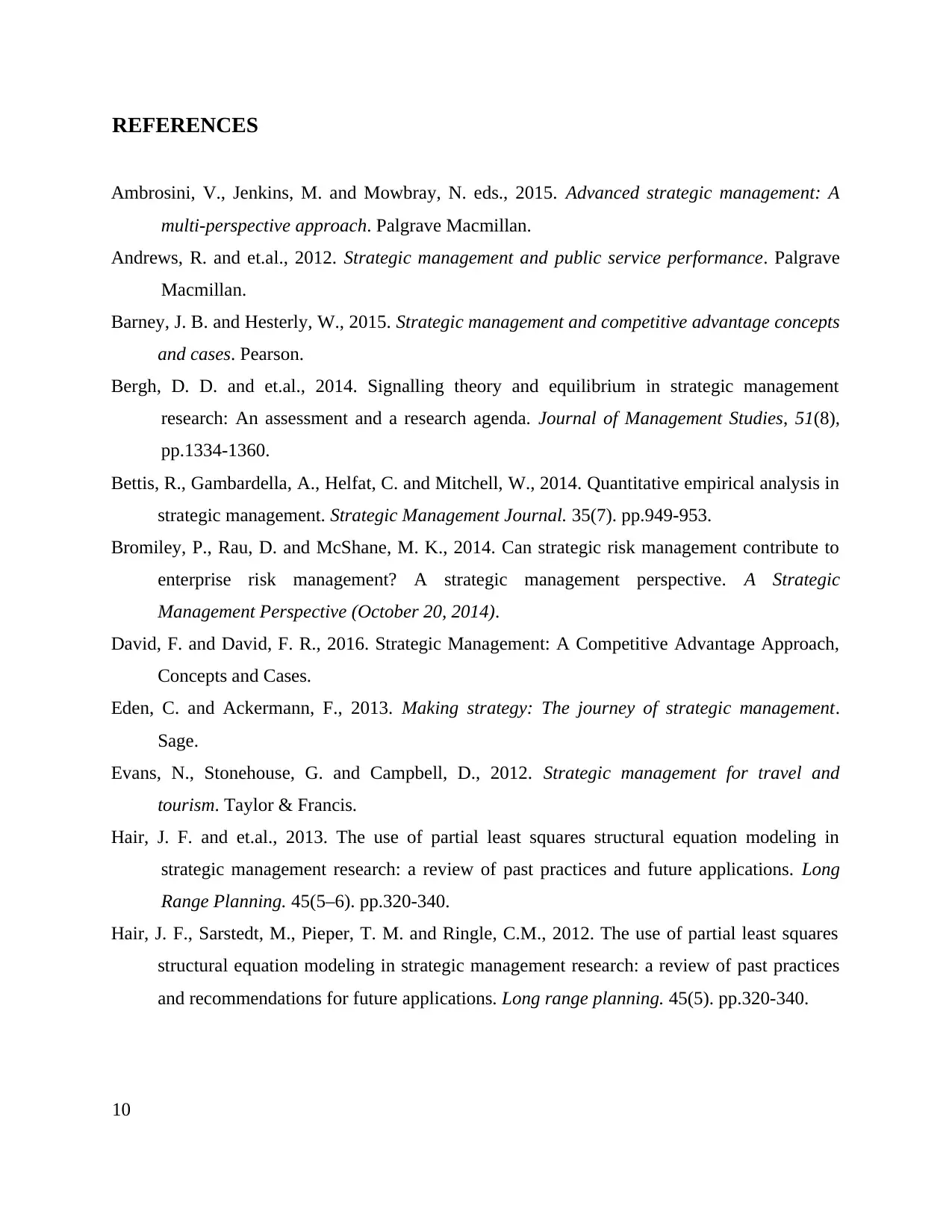
REFERENCES
Ambrosini, V., Jenkins, M. and Mowbray, N. eds., 2015. Advanced strategic management: A
multi-perspective approach. Palgrave Macmillan.
Andrews, R. and et.al., 2012. Strategic management and public service performance. Palgrave
Macmillan.
Barney, J. B. and Hesterly, W., 2015. Strategic management and competitive advantage concepts
and cases. Pearson.
Bergh, D. D. and et.al., 2014. Signalling theory and equilibrium in strategic management
research: An assessment and a research agenda. Journal of Management Studies, 51(8),
pp.1334-1360.
Bettis, R., Gambardella, A., Helfat, C. and Mitchell, W., 2014. Quantitative empirical analysis in
strategic management. Strategic Management Journal. 35(7). pp.949-953.
Bromiley, P., Rau, D. and McShane, M. K., 2014. Can strategic risk management contribute to
enterprise risk management? A strategic management perspective. A Strategic
Management Perspective (October 20, 2014).
David, F. and David, F. R., 2016. Strategic Management: A Competitive Advantage Approach,
Concepts and Cases.
Eden, C. and Ackermann, F., 2013. Making strategy: The journey of strategic management.
Sage.
Evans, N., Stonehouse, G. and Campbell, D., 2012. Strategic management for travel and
tourism. Taylor & Francis.
Hair, J. F. and et.al., 2013. The use of partial least squares structural equation modeling in
strategic management research: a review of past practices and future applications. Long
Range Planning. 45(5–6). pp.320-340.
Hair, J. F., Sarstedt, M., Pieper, T. M. and Ringle, C.M., 2012. The use of partial least squares
structural equation modeling in strategic management research: a review of past practices
and recommendations for future applications. Long range planning. 45(5). pp.320-340.
10
Ambrosini, V., Jenkins, M. and Mowbray, N. eds., 2015. Advanced strategic management: A
multi-perspective approach. Palgrave Macmillan.
Andrews, R. and et.al., 2012. Strategic management and public service performance. Palgrave
Macmillan.
Barney, J. B. and Hesterly, W., 2015. Strategic management and competitive advantage concepts
and cases. Pearson.
Bergh, D. D. and et.al., 2014. Signalling theory and equilibrium in strategic management
research: An assessment and a research agenda. Journal of Management Studies, 51(8),
pp.1334-1360.
Bettis, R., Gambardella, A., Helfat, C. and Mitchell, W., 2014. Quantitative empirical analysis in
strategic management. Strategic Management Journal. 35(7). pp.949-953.
Bromiley, P., Rau, D. and McShane, M. K., 2014. Can strategic risk management contribute to
enterprise risk management? A strategic management perspective. A Strategic
Management Perspective (October 20, 2014).
David, F. and David, F. R., 2016. Strategic Management: A Competitive Advantage Approach,
Concepts and Cases.
Eden, C. and Ackermann, F., 2013. Making strategy: The journey of strategic management.
Sage.
Evans, N., Stonehouse, G. and Campbell, D., 2012. Strategic management for travel and
tourism. Taylor & Francis.
Hair, J. F. and et.al., 2013. The use of partial least squares structural equation modeling in
strategic management research: a review of past practices and future applications. Long
Range Planning. 45(5–6). pp.320-340.
Hair, J. F., Sarstedt, M., Pieper, T. M. and Ringle, C.M., 2012. The use of partial least squares
structural equation modeling in strategic management research: a review of past practices
and recommendations for future applications. Long range planning. 45(5). pp.320-340.
10
Paraphrase This Document
Need a fresh take? Get an instant paraphrase of this document with our AI Paraphraser
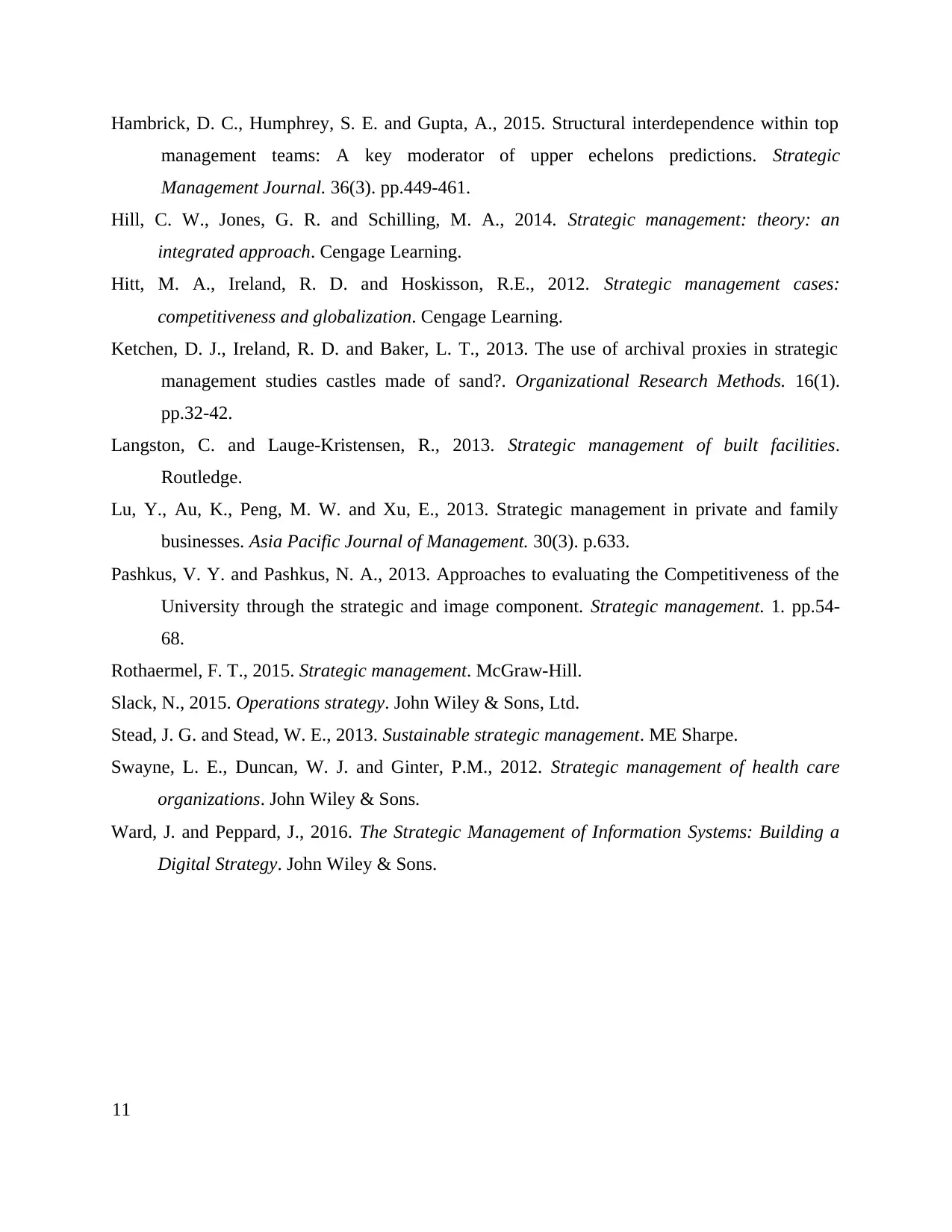
Hambrick, D. C., Humphrey, S. E. and Gupta, A., 2015. Structural interdependence within top
management teams: A key moderator of upper echelons predictions. Strategic
Management Journal. 36(3). pp.449-461.
Hill, C. W., Jones, G. R. and Schilling, M. A., 2014. Strategic management: theory: an
integrated approach. Cengage Learning.
Hitt, M. A., Ireland, R. D. and Hoskisson, R.E., 2012. Strategic management cases:
competitiveness and globalization. Cengage Learning.
Ketchen, D. J., Ireland, R. D. and Baker, L. T., 2013. The use of archival proxies in strategic
management studies castles made of sand?. Organizational Research Methods. 16(1).
pp.32-42.
Langston, C. and Lauge-Kristensen, R., 2013. Strategic management of built facilities.
Routledge.
Lu, Y., Au, K., Peng, M. W. and Xu, E., 2013. Strategic management in private and family
businesses. Asia Pacific Journal of Management. 30(3). p.633.
Pashkus, V. Y. and Pashkus, N. A., 2013. Approaches to evaluating the Competitiveness of the
University through the strategic and image component. Strategic management. 1. pp.54-
68.
Rothaermel, F. T., 2015. Strategic management. McGraw-Hill.
Slack, N., 2015. Operations strategy. John Wiley & Sons, Ltd.
Stead, J. G. and Stead, W. E., 2013. Sustainable strategic management. ME Sharpe.
Swayne, L. E., Duncan, W. J. and Ginter, P.M., 2012. Strategic management of health care
organizations. John Wiley & Sons.
Ward, J. and Peppard, J., 2016. The Strategic Management of Information Systems: Building a
Digital Strategy. John Wiley & Sons.
11
management teams: A key moderator of upper echelons predictions. Strategic
Management Journal. 36(3). pp.449-461.
Hill, C. W., Jones, G. R. and Schilling, M. A., 2014. Strategic management: theory: an
integrated approach. Cengage Learning.
Hitt, M. A., Ireland, R. D. and Hoskisson, R.E., 2012. Strategic management cases:
competitiveness and globalization. Cengage Learning.
Ketchen, D. J., Ireland, R. D. and Baker, L. T., 2013. The use of archival proxies in strategic
management studies castles made of sand?. Organizational Research Methods. 16(1).
pp.32-42.
Langston, C. and Lauge-Kristensen, R., 2013. Strategic management of built facilities.
Routledge.
Lu, Y., Au, K., Peng, M. W. and Xu, E., 2013. Strategic management in private and family
businesses. Asia Pacific Journal of Management. 30(3). p.633.
Pashkus, V. Y. and Pashkus, N. A., 2013. Approaches to evaluating the Competitiveness of the
University through the strategic and image component. Strategic management. 1. pp.54-
68.
Rothaermel, F. T., 2015. Strategic management. McGraw-Hill.
Slack, N., 2015. Operations strategy. John Wiley & Sons, Ltd.
Stead, J. G. and Stead, W. E., 2013. Sustainable strategic management. ME Sharpe.
Swayne, L. E., Duncan, W. J. and Ginter, P.M., 2012. Strategic management of health care
organizations. John Wiley & Sons.
Ward, J. and Peppard, J., 2016. The Strategic Management of Information Systems: Building a
Digital Strategy. John Wiley & Sons.
11
1 out of 11
Related Documents
Your All-in-One AI-Powered Toolkit for Academic Success.
+13062052269
info@desklib.com
Available 24*7 on WhatsApp / Email
![[object Object]](/_next/static/media/star-bottom.7253800d.svg)
Unlock your academic potential
Copyright © 2020–2025 A2Z Services. All Rights Reserved. Developed and managed by ZUCOL.





